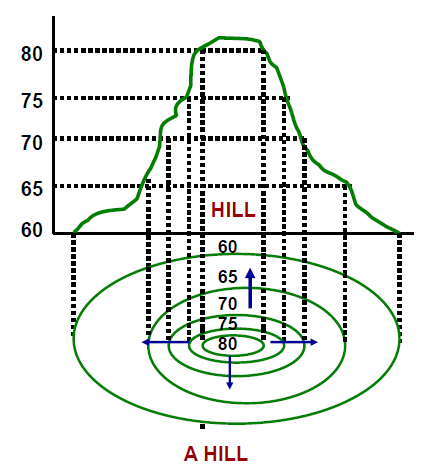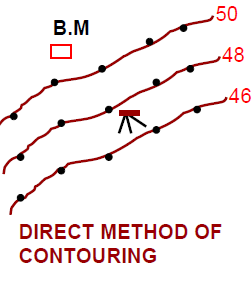Contour are the lines joining the points of equal elevation on the surface of the earth or we can say that, contour is a line in which the ground surface is intersected by a level surface obtained by joining points of equal elevation.
Contour Map – The map on which contour lines are plotted are known as contour map.
Contour map gives an idea of the altitudes of the surface features as well as their relative positions in plan serves the purpose of plan as well as section.
Contouring – The process of tracing lines on the surface of the earth is called contouring.
Contour Interval – the constant vertical distance or the difference in the level between two consecutive contours in a map is called contour interval.
Horizontal Equivalent – the horizontal distance between any two consecutive contours is called as horizontal equivalent.
The contour interval is unchanged or constant between the consecutive contours while the horizontal equivalent is variable and depends upon the slope of the earth surface.
Contour Gradient – a line laying on the ground which maintains a constant inclination to the horizontal is known as contour gradient. It is measured out by an instrument called Clinometer.
Characteristics of Contour
- Contour lines always form the closed loops, however they may close either on the map itself or outside the map.
- Contours are always perpendicular to the direction of steepest slope.
- All points in a contour line have the same elevation.
- For a given contour interval, scale of the map and the nature of the terrain decide the horizontal equivalent. As the slope becomes more and more steeper, the horizontal equivalent decreases.
- If the contours are parallel and the horizontal difference between two consecutive contour is constant for a map, than the contour shows uniform slope.
- Straight, parallel and equally spaced contour lines represent a plane surface.
- Irregular contours represents rough terrain.
- For depressions, the contour value is decreasing from outside towards centre.

- For a hill contour mapping, the contour value is increasing from outside towards centre.

- Contour lines cross the ridge at right angles. If the higher values are inside the bend or loop in the contour, it indicates a ridge.

- Contour lines cross the valley at right angles. If the higher values are outside the bend, it represents a valley.

- Two contours of different elevation neither cross each other nor joins. However, in the special case of an overhanging cliff or a cave penetrating the hill inside, the contours appear to cross each other.


Methods of Contouring
There are mainly two methods of locating contours:
1. Direct Method of Contouring
2. Indirect Method of Contouring
1. Direct Method of Contouring
In this method, the contour to be plotted is actually traced on the ground by locating the points of that elevation. The horizontal position of the points so located is then determined and plotted on the plan. The pegs of different contours are coded so that one set cannot be mistaken for the other.

- This is more accurate method than the indirect methods as the points are located directly and in generally used for small areas.
- The main disadvantage of this method is that the method is slow and cumbersome and is not suitable for contouring large areas.
2. Indirect Method of Contouring
In this method the points located and surveyed are not necessarily on the contour lines but the spot levels are taken at some selected points called as guide points and the levels of the points are determined. The horizontal positions of these points are then determined and points are plotted on the plan. Their positions are then plotted on the plan and the contours drawn by interpolation.
This method of contouring is also known as contouring by spot levels. The indirect method is more convenient than the direct method and is suitable for contouring large areas.
There are mainly three method of contouring in indirect method
a. Grid Method or Square Method
This method is used for the surveying of small to medium areas and for the less undulated land.
- The area to be surveyed is divided into a number of squares, the size of the squares depends on the nature of ground and the contour interval. Usually it varies from 5 m to 30 m.
- From the elevations of the grid points, the points on the various contours are located by interpolation.
b. Cross Section Method
This method is most suitable for the surveys of long narrow strip such as a road, railway or canal etc.
- Cross sections are located on the ground at right angles to the fixed line or center line of the route. The cross section lines need not necessarily be at right angles to the center line of the work. This may be inclined at any angle to the center lines of the cross section.
- Depending on the nature of ground and the contour spacing, the spacing of cross sections is decided.
- The common value is 20 to 30 m in hilly country and 100 m in flat country.
- The levels of the points along the section lines are plotted on the plan and the contours are then interpolated as usual.
c. Radial Lines Method
This method is particularly useful for contouring small hilly areas where radial lines are drawn from a peak to cover the entire area.
- Grid points are taken on the radial lines and their elevations are determined.
- The contour lines are drawn through interpolation.
d. Controlling Point Method
Here the elevations are determined for a few selected key or controlling points. The contour lines are then drawn through interpolation.
- This is however an approximate but quick method.
- For fairly uniform sloping ground, this method gives quite good results.
Uses of Contour Maps
There are lots of uses of contour maps as the contour survey is carried out at the starting of any engineering project such as a roadway, railway, canal, dam, building etc. Some of the major uses are as follows.
- For the assessment of the terrain character.
- Used to select the most economical or suitable site.
- To locate the alignment of a canal so that it should follow a ridge line.
- To mark the alignment of roads and railways so that the quantity of earthwork should be minimum.
- Used for the assessment of catchment area and volume.
- To trace out the given grade of a particular route.
